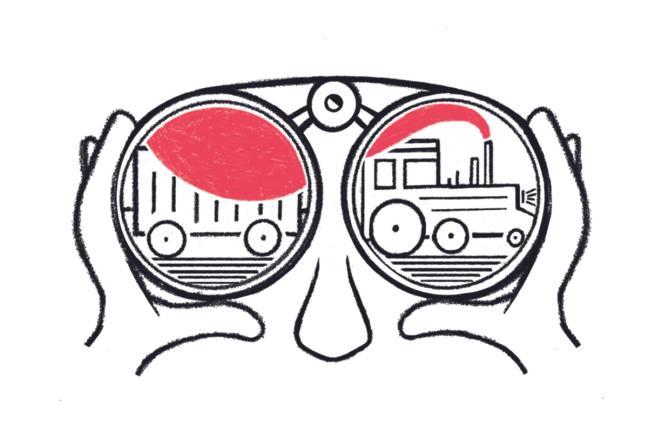Francis Bourgeois on why he spots trains
Visit any railway station in the UK, especially on the mainline, and have a look at the end of the platform. Almost certainly there will be a trainspotter. Sometimes there will be a crowd, at other times just a handful, depending on what’s coming through. Trainspotters and train enthusiasts can be any age, any gender, any temperament.
It’s easy to identify us: a notepad, a camera, sitting on a bench waiting for a locomotive to pass through, standing at the end of the platform setting up a shot. “Are you here for the railtour?” – a question that can turn a nomadic outing into an adventure with fellow enthusiasts. Trainspotters like me can find instant camaraderie through our mutual appreciation for the iron horses that gallop across our network.
In the UK, trainspotting began in the early 19th century when rail travel was just emerging. The act of being a trainspotter wasn’t necessarily recorded back then, but no doubt there would have been wide-eyed children, quietly appreciative parents and curious grandparents marvelling at George Stephenson’s Rocket as it chugged along at 30mph. By the 20th century, the romance of travelling by train and the beauty of steam locomotives began to fuel a fascination with the railway. The Duchess of Hamilton; the Flying Scotsman; the class A4s, particularly the Mallard [1] that, in 1938, broke the record for the fastest steam locomotive, achieving 126mph in Lincolnshire — all brought the bold image of the railway into the minds of the general public.


Subsequently, the numbers on the sides of locomotives, not just the hero engines but the workhorses of the shunting yards, introduced a new dimension to trainspotting in this era. Nearly 20,000 steam locomotives ran along the network towards the end of the 1930s, all with unique numbers, some with names, to be collected by trainspotters, along with other relevant information, and compiled in a book. Just the same way someone might collect stamps or coins.
After the Second World War, the railway industry went through drastic changes: diesel locomotives started to take over from their steam counterparts, compounded by the modernisation plan of 1955, whereby manufacturers were commissioned to create multiple classes of electric and diesel locomotives in small batches. Through trialling on the network, the most reliable, powerful and efficient locomotives were selected for further orders. This created a hive of separate classes of diesel locomotives operating in different regions with varying degrees of rarity, manufactured by individual companies with different engines, while steam was shouting its last hurrah.
It was certainly an exciting time to spot trains. Lines of children would sit with their legs over the edge of the platform, all with notepads, writing down numbers, while older spotters stood behind. Through the 1970s and 1980s, electric and diesel locomotives and multiple units dominated the lines. Steam was no longer the principal source of power. Railway photography became an increasingly popular way of cataloguing locomotives that had been spotted.
The 1990s, the era of privatisation, brought new liveries. Spotters were now capturing moments on camcorders, though numbers were still being taken down in trusty notebooks. In the early 2000s, the diesel and electric relics of the previous century started to fall away, replaced by more efficient, less polluting and quieter locomotives and multiple units. Some of the original trainspotters started to fall away too.
“Different parts of my brain are tickled by the railway”
Trainspotting found a home on sites like Flickr and Facebook in the 2010s: a game-changing way to share the rare movements on a particular day. Instagram enhanced this, then TikTok. A new, younger generation of trainspotters have started to emerge and connect with one another. The station platforms of the last century are now virtual, with enthusiast groups, spotting group chats and social media feeds bringing enthusiasts together. The platforms are full, and I am glad to be part of it.
Different parts of my brain are tickled by the railway. The huge amounts of momentum in a moving train, juxtaposed by the directional restriction of the rails, gives me an odd sense of calm. There is so much predictability in the direction of the train; it’s clear what is going to happen next. Trainspotting also taps into my desire to collect things, which began with Hot Wheels cars when I was a toddler and, later, noting down details of cool cars that I had seen. Nowadays I record my locomotive encounters in videos and photos, which I order and date.
“What may just be the ambience of a commute is, for me, an anthem for my passion”
The main stimuli from the railway for me are the sounds: screeching rails, vibrating metal, groaning traction motors, thrashing diesel power units, explosive tones. Sonic energy from the railway gives me goosebumps and electricity in my body. I can happily ride along and listen to a class 455 with its refurbished Vossloh Kiepe [2] traction motors all day, swinging up and down with the pitch of the motors. The tunnel just after Leatherhead is a particularly great spot for an exhibition of the animal-like scream from beneath the carriages. What may just be the ambience of a commute is, for me, an anthem for my passion.
When I came to write my first book, The Trainspotter’s Notebook, I wanted to present trainspotting in its totality. Complete moments of elation. Dampening moments of disappointment. From chasing trains into the depths of Wales to reconciling the status quo of cool with my lifelong hobby. I wanted to give an insight into trainspotting, which from the outside might seem weird, even potentially puzzling as to why someone would stand at the end of a platform or on an overbridge for hours, or drive hundreds of miles in the lashing rain or beating sun, just to see a train.
I hope that it will also help remind people of their childhood passions and, maybe, if they are lying dormant, to reconnect with the joyful feelings of youth. And for fellow trainspotters reading this, particularly those at school, hold on to your passion. The general perception of what is cool may weather your connection to the hobby, but keep it true to yourself. Trains are cool.
[1] The Mallard, a striking, art deco-styled train, reached the still-standing record speed on 3rd July of that year, driven by Joe Duddington and fireman Thomas Bray.
[2] Known as Kiepe Electric GmbH since 2017, the Düsseldorf-based company also specialises in conveyor belts.
Railway Enthusiast Terminology

A-Z
↓ BASH
To travel on a particular train in order to experience a desirable locomotive in action
↓ BOWLED
When the view of a train or locomotive you are hoping to see is blocked by another train passing in front of it
↓ CAB RIDE
Riding in the driver’s cabin at the front of the train
↓ CHOPPERS
Nickname for class 20s, due to the chopping sound of their exhaust
↓ CLAG
Soot that is chucked up in the exhaust, creating a dark cloud
↓ CRANK
A railway enthusiast
↓ ECS
Empty coaching stock; the train is without passengers and is not in service
↓ FLAIL
Waving an arm up and down in appreciation for a good locomotive
↓ FLYING BANANA
Nickname for the New Measurement Train (NMT) as the whole train is yellow and can travel at speeds of up to 125mph
↓ GEN
Information on when and where a locomotive is going to be or what service it will be running
↓ GRONK
Nickname for class 08 shunters
↓ GROWLER
Nickname for class 37 locomotives
↓ HELLFIRE
A phrase that is usually shouted when an amazing trainspotting moment occurs on the railway
↓ HST
High speed train. Debatably, the only time to use this is when referring to the class 43
↓ INSECTS
Young railway enthusiasts
↓ KETTLE
Steam locomotive
↓ LIGHT ENGINE
When a locomotive is travelling by itself without a train
↓ RAILTOUR
A private charter train run specifically for railway enthusiasts
↓ THRASH
The noise produced when a locomotive is powering up, particularly by loud locomotives like class 37s
The Trainspotter’s Notebook by Francis Bourgeois is available now (Bantam Books, £20)
Want more interviews? Read our feature on why music producer Labrinth is dreaming of going intergalactic…
Become a Gentleman’s Journal member. Find out more here.

Become a Gentleman’s Journal Member?
Like the Gentleman’s Journal? Why not join the Clubhouse, a special kind of private club where members receive offers and experiences from hand-picked, premium brands. You will also receive invites to exclusive events, the quarterly print magazine delivered directly to your door and your own membership card.